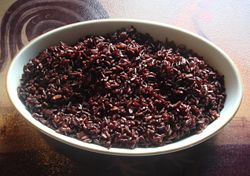TRENDS: Black, The New Color Of Health Food?
| McCormick came out with black food coloring this fall (it did not previously exist at the consumer level, so now you can ice chic [or goth] cupcakes to your heart’s content). Based on a food trend reported by Florida’s Sun Sentinel, McCormick may be an American trendsetter. Ebony-colored foods are red-hot in Japan and other parts of Asia, and the trend may be headed west. Black foods have been eaten for hundreds of years in Japan for their rich taste (deeper-colored foods generally have more profound flavors). But now, people are buying them for their nutritional value. |  Black rice, also known as “forbidden” rice (see our Rice Glossary for more information). |
|
| The black-food fervor in Japan began a few years ago with a cocoa drink spiked with black soybeans. Next, a black-soybean tea was granted FOSHU status (foods for specified health use), the Japanese equivalent of an FDA-approved health claim. Black vinegar drinks are promoted as tonics to lower blood pressure and cholesterol levels. Black soybean coffee and black soy milk have become popular. On the food side, there are black rice, black sesame biscuits and cereal, and black soybean coffee. If you want to jump the trend, the Sun Sentinel suggests: – Black Beans. The familiar black bean contains more antioxidants (including anthocyanins) than any other bean. Add them to chili, soups and salads. Read more in our Bean Glossary. – Black Rice. This whole-grain rice contains more fiber and nutrients compared to white rice. Some varieties look purple when cooked (see the photo above). We love making Thai rice pudding with black rice and coconut milk. Read more in our Rice Glossary. – Black Soybeans. High in protein, fiber and anthocyanins, black soybeans may be better at lowering cholesterol levels than yellow soybeans, according to Japanese researchers. – Black Vinegar. A dark vinegar typically made from brown rice, it’s an Asian version of balsamic, aged to give it a woodsy and smoky flavor. Find it Asian markets. Read more in our Vinegar Glossary. – Blackberries. The purplish-black berries have among the highest antioxidants of any fruit. – Nigella Seeds. Also called black onion seeds, these tiny jet-black seeds are staples in Indian and Middle Eastern cuisine. They have a nutty, peppery flavor and are used as a seasoning for vegetables, beans and bread (including naan). Find them in ethnic markets. – Black Mushrooms. Aromatic and rich in flavor, black mushrooms include shiitake, wood ear and black trumpet. Dried versions are easily found in Asian markets. Read more in our Mushroom Glossary. Perhaps you’ll be inspired to whip up a New Year’s Eve dinner with black foods in every course, to celebrate a healthy new year. |
||


